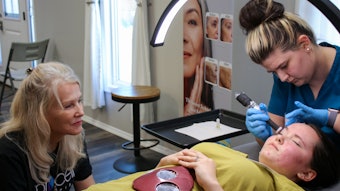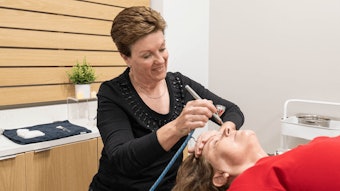Following are the interview transcripts from the article, "Choosing the Right Spa Software," by Cathy Christensen, that appeared in the March 2008 issue of Skin Inc. magazine.
Barbara Stirewalt, spa director, The Spa at Mohonk Mountain House, New Paltz, New York
Mohonk reviewed a large number of choices and brought it down to finalists (three) and issued a request for a proposal, which is normal for significant purchases. We had complicated criteria, greater than being spa software. We are part of a hotel, so we needed to see if the software could support rooms management or interface properly with that type of a system, because you want you guest to have a seamless experience. We had other things in the resort that had to be considered to be supported by the software. Those criteria made it complex. In the end, when I talked to our IT people about it, he said that we wanted to make sure that the accurate booking process could be easy for the customer, easy for us to train our staff to do, and that equates to good service. Customers want the process of booking, arriving, transacting to be easy, quick and efficient. I know that we are growing toward online bookings, but spas still have a personal touch to it. I still want it to be somewhat efficient. That process of booking a spa appointment is intuitive for the staff and flows well for the customer. We have the answers for our customers right at our fingertips. It boiled down to how the software could help us to serve our customer. That’s the history of it.
What features does a busy spa need to look for when choosing a software? It’s something that needs to be taken to heart. First of all, customer care of the spa. One of the things that is so fantastic about the industry is that successful spa product lines are successful because of the customer care they give their spas. They fail if they don’t do what they need to do as customer care people. They have to provide great service, training, follow up and one-on-one account management. IT for spas need to learn from them. My fear in information technology is a culture that sells something to you and waits for you to call when you have problems, and we are making those calls when we are crashing. Any spa should look for a company with a proven and proactive service philosophy. Talk to the other spas they work with about this and find out how they work when you aren’t crashing because it is a tool just like everything else.
Innovation: Spas are unique and are creative. Service menus and the need to be creative is inherent to us. We want to do packages, do add-ons, please customers. We are looking for a software with a flexibility factor. They need to get to know us to know you as a customer and know how you operate to build a backbone of service.
Reporting. Spa directors wear a lot of hats and one is the business manager, and one of them is to project the future and we all need budgets. Every day, we seek to review our business a different way. If you can create a question, I need a report to answer it. Part of it is marketing. Reports help us determine those things. Spa software that is worth gold will give the manager dynamic reporting to help them make their business decisions.
Retail management: Many spas are expecting significant retail features and inventory management and reporting. When Mohonk was making their choices, this was a big indicator. And because I know more than one system, retail management is really important and having it be advanced. There is a lot of really neat stuff out there with retail capabilities. Evaluate the people behind the software company: Are they hospitality people, retail people, IT people: It’s good to know where they come from, what their backgrounds are and what got them into the wonderful business of ours.
We had criteria that was unique and we had all these other things, too. The IT guy didn’t say that it needs to be so simple, I could feel that he was seeking it. Software is really complicated and not intuitive and that always translates into a bad customer experience. ISPA had a focus group: This one woman said, “Make sure you pay before you go in. It will ruin everything you achieved with your relaxing spa experience.” She was right on. It was really complicated. Software has come a long, long way.
They’ve all gotten payroll options, we are past that now. Everyone is on the same playing field there. Spa software has developed significantly during my nine years of being in the business.
Angela Cortright, principal, Spa Gregorie’s, Newport Beach, California
The first thing they should do is look at all of the things that they do every day—they open their cash drawers, move appointments, book appointments—look in detail at all of their functions that would be handled by the software and come up with a list of questions that they would ask a supplier. Demos are really critical.
The most critical thing is functionality, but beyond that is how user friendly is it. I’ve seen programs that take weeks to learn. You want to have your front desk person to be able to be up and running in a day.
I think that, for most people, what comes out of the box will satisfy 95% of their needs, but most have the ability for customization if that is what the customer needs. It’s really valuable to network as much as possible with other businesses in the industry to find out what they are doing. Ask them if they had it to do over again, what would they do differently? Talk to as many people as possible to get some education.
Support is critical and you need to speak candidly with your peers, not with company referrals. You need to find out truthfully about the support. You need to have someone at the other end of that phone 24/7. If you don’t have good support you are dead in the water. You might as well not have any software.
Even though you have a wonderful computer system, things happen. I always advise to have a backup plan. Every night, we run a paper-based appointment schedule for the next day. Things happen. Make sure that you have the ability to run your business tomorrow if a disaster happens.
Bryan Durocher, president, Durocher Enterprises
The first thing is that your software program has to be able to handle your clients info and files, your point-of-sales for services and retail, and you have to make sure as you’re looking for that. If you are going to have an extensive retail selection, ask the software company how many SKUs you can have in your inventory—you don’t want to be limited.
You’re going to want that it is able to track the professional inventory you use when you are providing treatments.
Track business info—my key productivity indicators of my providers and what they are offering. Tracks prebooking, client retention; I want retail sales, service sales and want to break down services by category so I can see what type of business a provider is doing. I want to make sure that 50% of my massage therapists are upselling, and not just doing Swedish massages. I want it to track client referrals so my face to face marketing is working so I can reward my clients who are referring new business. These are critical things to track. A lot of software doesn’t track prebooking. Then I can start forecasting my numbers.
These are things that spa owners want to ask right off the bat.
I want a program that will handle compensation—and complex compensation on different tiers and levels. I have all my client history so that I can make the appropriate recommendations and speak intelligently about the client. It’s all automated. You want your software to have different levels.
I think people can purchase an out-of-the-box program and be happy with it. There aren’t that many variables. The programs … you can get one and you’re labeling your stuff, which is standard. It’s very rare for the average spa to need a heavily customized program.
The other things programs offer are the ability to e-mail to clients. Others will allow you, if you have open booking times, to cross-book manicures and services, etc. Do I see a lot of people using them with direct mail pieces? No.
Another thing that is good—productivity reports so that you know how to staff appropriately.
Weed through the list. Get references of who the people have worked with. Good technical and customer service support. So many of these companies sell you the software and you can never get them on the phone. What is their tech package? What’s going to help me maintain my business and grow? Updates for software are they free, do I purchase them when they’re available? They will try to lease you the software versus selling it to you. Leasing may look like a good idea, but you are paying for that software forever. Buying is usually best and most will give those updates free. If I was paying $150 a month, I’m constantly paying for it. Am I paying for each computer that runs it or can I network together? Don’t buy the hardware from the software company. Most spas don’t need super computers to run these programs. Buy it separately because software companies will have a huge premium on that with a huge markup. Does it have gift card integration? That could be really handy to have it all rolled into one.










